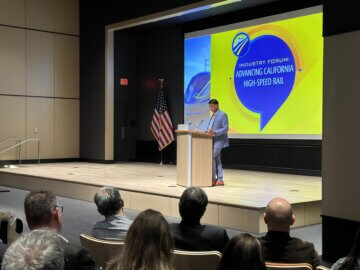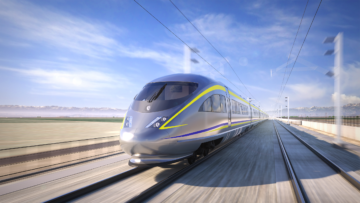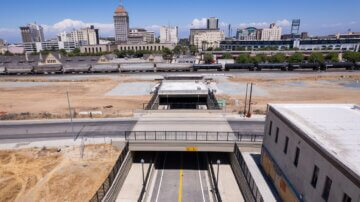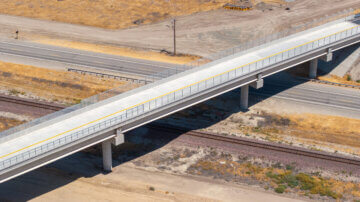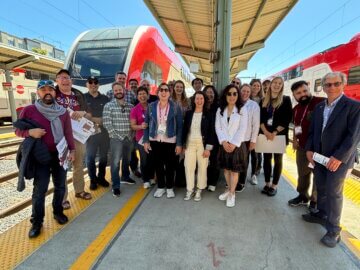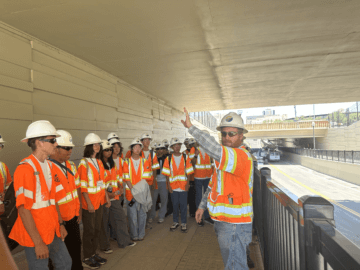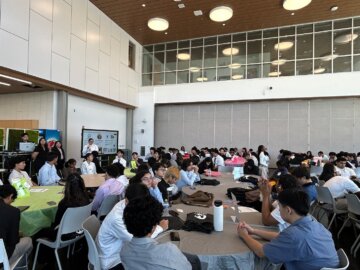|
重大新聞 |
合作夥伴更新 |
外聯更新 |
加州推動高鐵穩定融資協議
9月19日,加州州長加文·紐瑟姆簽署了與州議會協商的協議,重新授權限額投資計劃,並承諾每年向加州高速鐵路管理局(簡稱“管理局”)提供1500億美元的歷史性資金,直至2045年。這是該計劃迄今為止獲得的最大資金注入保證。
首席執行官伊恩·喬德里 (Ian Choudri) 稱該協議是“對加州未來的大膽聲明——它將創造就業機會、減少污染、連接和改變全州的社區。”
這將為高鐵專案提供穩定且可預測的資金流,從而提高規劃的確定性並提高專案交付的效率。資金保障還能提高專案吸引私人資本和前期利用現有資金的能力,從而加快交付速度並降低長期成本。
這項最低資金水準和 15 年的延期將涵蓋在中央谷地建造默塞德至貝克斯菲爾德路段的費用,從而有效彌補資金缺口。
執行長 Ian Choudri 分享高鐵第一年的新願景
2024年8月,交通管理局董事會批准任命Ian Choudri為該計畫的新任首席執行官,負責將計畫從規劃階段過渡到營運階段。此後,他對交通管理局進行了重組,使其更像一家企業,確保高效、負責、執行更快。執行長Choudri上任第一年就與全州各地的交通利益相關者和當地合作夥伴就該計畫的新方向進行了溝通。這些變化也吸引了包括私營部門在內的世界各地受眾的支持和關注,因為他們展示了交通管理局正走在一條大膽的新道路上,以更快、更聰明、更經濟的方式交付成果。以下是一些亮點的簡要回顧:
為迎接2025年的到來,鐵路局舉辦了一場為期兩天的行業論壇,取得了圓滿成功,超過400名來自鐵路系統、建築、設計、技術和金融公司的代表出席了論壇。來自全國各地,甚至一些來自世界各地的專家和創新者與鐵路局會面,提供了寶貴的回饋意見,幫助我們做出關鍵決策,塑造計畫的未來。鐵路局將繼續尋求私營部門的回饋和建議,以指導我們未來的採購策略,包括發布 徵求意向書 今年春天,雙方就高鐵專案首選交付策略的商業、財務、技術和採購方面進行了磋商。
今年五月,執行長喬德里出席了在華盛頓特區舉行的美國高速鐵路協會年會,在全國舞台上亮相。他的演講題為“推進美國西南部首個真正的高速鐵路系統”,介紹了該項目目標的進展情況,以及與Brightline West和High-Desert Joint Powers Corridor達成的協議,該協議旨在將我們的高速鐵路系統與他們的高速鐵路系統連接起來,打造美國首個州際高速鐵路網絡。
6月,執行長Choudri作為特邀演講嘉賓出席了在舊金山舉行的美國公共交通協會(APTA)高速鐵路研討會。他與來自開發和投資公司的高管一起,參加了“公私合作與高速鐵路”專題討論會,面向來自世界各地的鐵路客運專業人士。該專題討論會探討了P3模式的優勢,即如何更快、更有效率地交付項目,同時實現列車組、車站設施、軌道交通、光纖和房地產等資產的商業化。
執行長喬德里也一直在與全州各地的媒體人士討論地方和全州高鐵的下一步發展計劃。 《聖荷西水星報》近期刊登的文章 這裡 和 這裡,《弗雷斯諾蜜蜂報》的正面社論 這裡, 這裡, 和 這裡以及長篇文章 《富比士》, 吉隆坡國際機場, 街頭部落格,以及 舊金山紀事報 展示 Choudri 致力於與公眾分享該項目重新構想的方向。
新領導層帶來了高鐵的新願景。執行長喬德里走遍了加州乃至全國,與公眾、媒體和關鍵利益相關者溝通,傳達了這個創新願景。憑藉著新的活力和視角,該計畫正穩步推進,致力於為所有加州居民打造一個現代化、清潔的交通系統。
當局加速2026年鐵路安裝時間表
8月28日,鐵路局董事會批准發出高速鐵路軌道及其他所需系統組件的招標邀請,這是加速軌道和系統建設的重要里程碑,預計明年開工。在鐵路局位於克恩縣的南部鐵路樞紐項目即將完工之際,這項批准為美國製造商在六個獨立採購項目中參與競標打開了大門。
鋪設119英里(約190公里)路段所需材料將100%由州政府資助,涵蓋多種商品,包括鋼軌、枕木、架空接觸網桿、光纖電纜和EN道碴,總核准成本為15.07億美元,將分批授予多個合約。所有材料均為全新製造,並符合「購買美國貨」和「建設美國,購買美國貨」法案的規定。招標將於2025年8月或之後開始。 您可以在此處了解有關此操作的更多信息.
當局完成另外兩棟建築
今年夏天,該局已完成兩座建築,至此,今年已完成的建築總數達到七座,自開工以來,中央谷地已完成近 60 座建築。
8月21日,圖萊裡縣88號大道立體交叉竣工。該立體交叉由承包商Dragados-Flatiron合資公司建造,將改善農業設備、緊急救援人員和車輛的通行。該立體交叉位於43號州際公路附近,長485英尺(約146公尺),寬超過32英尺(約9.6公尺)。 您可以在此處了解有關此結構的更多信息.
7月下旬,管理局以及當地和州領導人在弗雷斯諾歷史悠久的唐人街舉行了剪綵儀式,慶祝圖萊里街立體交叉計畫的竣工。現在,這條地下交叉道將車輛交通引導至聯合太平洋鐵路和未來高速鐵路軌道下方20多英尺處。它是一條雙車道公路,長1000多英尺,寬60英尺,設有供居民和騎自行車者使用的人行道和自行車道,在提高安全性的同時,減少了溫室氣體排放和不健康的污染物。該項目意義重大,因為它將弗雷斯諾唐人街與市中心在數十年分裂之後重新連接起來,改善了交通和流動性,支持了長期經濟增長,並為高速鐵路奠定了基礎。 您可以在此處了解有關此結構的更多信息.
| 合作夥伴更新 |
北加州的夥伴關係和進步
在舊金山舉行的 2025 年美國公共交通協會 (APTA) 鐵路會議上,來自世界各地的交通運輸業高管透過兩次參觀親身體驗了高速鐵路項目,展示了合作夥伴關係和進展。
週六上午,交通導向開發項目參觀團參觀了Salesforce交通中心,包括已建成的地下車廂、加州高鐵和加州火車的未來終點站,以及周圍近19英畝的住宅、商業和開放空間。該社區透過一項名為「跨灣計畫」的雄心勃勃的規劃和開發項目進行了改造。
這次參觀由跨灣聯合權力機構 (TJPA) 執行董事亞當范德沃特 (Adam Van de Water) 帶領,該機構擁有並運營交通中心,即舊金山未來高速鐵路的所在地。
范德沃特稱其為「美國最成功的交通導向開發項目之一」。他解釋說:“在過去的二十年裡,TJPA及其合作夥伴將數英畝的停車場和高速公路匝道改造成了舊金山最令人興奮的新社區,擁有九家交通運營商,數百萬平方英尺的新開發項目,目前有超過15,000名新居民居住。”
當天晚些時候,25名與會者乘坐了新近電氣化的加州火車系統,並參觀了未來將成為高鐵北部終點站的多式聯運Salesforce交通中心。加州鐵路局為加州火車走廊電氣化項目投資超過1500萬美元,這不僅為該項目提供了資金,也為該走廊未來的高鐵服務做好了準備。
加州火車現代化專案總監謝裡·布洛克 (Sherri Bullock) 闡述了電氣化帶來的益處。她解釋說:“電氣化使我們能夠安全地共享基礎設施。它通過實現更快的加速、更短的停留時間和更高的服務頻率來提高線路容量,同時減少排放。這不僅對加州火車而言是一個重要的里程碑,對整個加州一體化現代化鐵路的未來也意義非凡。”
遊覽於 4 點開始日 和國王站,然後搭車前往密爾布瑞站。亮點包括舊金山四條歷史悠久的百年隧道,以及布里斯班擬建的北加州輕軌維護設施。嘉賓們聆聽了不同類型的通道、舊金山國際機場周圍複雜的基礎設施以及火車站周圍正在建造的新住宅。來自 HNTB 公司的 John Litzinger 為簡報和討論貢獻了他的技術專長。
| 外聯更新 |
交通運輸學生參觀高鐵亮點
「世界上最快的高鐵運行時間記錄是在哪裡創造的?時速接近 357 英里。」幾名米內塔夏季交通學院 (MiSTA) 的學生毫不猶豫地給出了答案:“法國:TGV。”
當這些高中生——未來的交通領袖——看到正在中央谷地建造的加州高速鐵路計畫的結構時,他們顯然對高速鐵路充滿熱情。
此次行程是聖荷西州立大學米內塔交通研究所(MTI)為對交通及相關領域感興趣的學生舉辦的為期三週的實踐計畫的一部分。 MiSTA 的一大特色是幕後參觀交通基礎設施和系統,例如機場和火車站。
7月16日,德國鐵路營運商德國鐵路(DB)的丹尼爾·海涅(Daniel Heine)在從聖荷西出發的巴士上為28名學生做了情況介紹,拉開了中央谷地建設之旅的序幕。德國鐵路是該管理局的早期列車營運商,負責策略性列車服務規劃和系統整合。海涅向學生介紹了技術和政策問題。他強調了鐵路運營的安全性以及高速鐵路的環境效益。
管理局公共資訊官奧吉·布蘭卡斯 (Augie Blancas) 在弗雷斯諾 (Fresno) 帶領學生們參觀並進行現場情況介紹,他提醒學生們:「我們將前往一個正在施工的工地,安全始終是我們的首要任務。」 每次停留前都會重複進行安全簡報。
隨後,學生們前往弗雷斯諾市中心地下的圖萊里街地下通道,並參觀了東南方向的雪松高架橋頂部。在地下通道,管理局工作人員向學生介紹了混凝土施工技術以及排水對地下結構的重要性。
這趟旅程的亮點是攀登雪松高架橋,它全長超過3700英尺,寬超過40英尺。簡報介紹了該地塊的建造歷史和設計細節,以及攀登如此龐大基礎設施的安全措施。
2025 學院由 FRA 的綜合鐵路基礎設施和安全改進 (CRISI) 撥款計劃資助,該計劃致力於提高城際客運和貨運鐵路的安全性、效率和可靠性。
「我們希望這些學生能夠直接向工程師、規劃人員以及外展和傳播人員學習建造大型基礎設施項目所涉及的方方面面,」MTI營運總監Alverina Weinardy說。 “透過讓他們了解高鐵建設的幕後歷程,我們希望激勵下一代從事交通運輸行業,這將改變我們的出行方式和生活方式。”
南加州外展回顧
K12 Foothill Consortium 高中實習生計畫入職參觀
今年夏天,南加州團隊歡迎來自 Charter Oak、Monrovia、Duarte 和 Azusa 聯合高中區的 K12 Foothill Consortium 高中實習生參加他們與管理局的首次入職培訓之旅,這是他們暑期學生計畫的一部分。
他們的旅程始於洛杉磯聯合車站 (LAUS) 的參觀。在洛杉磯鐵路遺產基金會首席營運官賈里德·尼格羅的帶領下,他們分享了該車站的悠久歷史及其在加州鐵路遺產中扮演的角色。隨後,學生們享用了午餐,並參觀了該局目前在洛杉磯聯合車站對面歷史悠久的法式蘸醬餐廳 Phillipe the Original 舉辦的展覽。他們觀看了列車室的展品,同時參與了一位實習學生與該局員工合作完成的重新設計,這是她學生專案的一部分,預計將於九月首次亮相。當天的行程在聯合車站的南加州辦公室結束,學生們在那裡進一步了解了這個覆蓋全州的項目以及多樣化的職業機會。 要了解有關這些學生專案的更多信息,請點擊此處.
洛杉磯公共圖書館招聘會
今年夏天,在洛杉磯公共圖書館的招聘會上,南加州團隊與50多位渴望了解加州高鐵計畫的求職者進行了交流。管理局工作人員介紹了專案的最新進展,並探討了職業發展路徑以及為有意從事技術行業人士提供的就業機會。管理局分享了中央谷地學徒前培訓計畫提供的機會,與會者對未來高鐵的職業發展前景充滿期待,並提出了許多關於職業發展路徑的問題。這項活動激發了人們的熱情,鼓勵社區進一步了解該項目,並學習如何做好準備,參與加州交通格局的歷史性變革。
我將騎行演示 - 洛杉磯地鐵交通職業學院 (TCAP) 項目
在今年的洛杉磯地鐵TCAP畢業典禮上,南加州管理局的工作人員向200多名實習生介紹了高鐵的未來發展,並強調了該計畫對全州交通、永續發展和未來就業機會的影響。
今年夏天,一位高中實習生首次在南加州與大家分享了她與南加州鐵路局員工合作的經歷,當時她正在協助菲利普·原汁原味餐廳(Phillipe the Original)進行重新設計。該餐廳的列車房內目前設有南加州鐵路局的博物館展覽。學生們透過實習生的經歷,進一步了解了這個獨特的機會,並向南加州鐵路局員工詢問了規劃、建設和職業準備等方面的問題。 TCAP 實習生們對了解該計畫和學生的經驗感到非常興奮,並表達了對高鐵未來的熱情。
該項目得益於英國鐵路局「我將乘車」的學生參與項目,該項目為學生探索鐵路客運運輸職業發展開闢了道路,並促進了銜接教育與就業準備的活動。歡迎前往菲利普畫廊 (Phillipe's) 參觀展覽!




